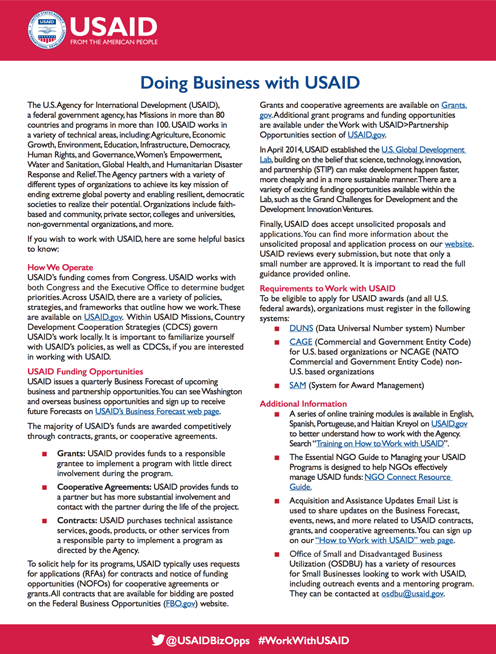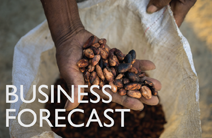USAID’s mission is to end extreme poverty, and promote resilient democratic societies. The Agency does this by partnering with individuals and organizations around the world. In partnering, we seek to find innovative and cost-effective solutions that help tackle global challenges.
Doing Business with USAID ![]() (pdf - 172k)
(pdf - 172k)
USAID has Missions in more than 80 countries and has programs in more than 100. We work in a variety of different technical areas, including: Agriculture, Economic Growth, Environment, Education, Democracy, Human Rights, and Governance, Women’s Empowerment, Water and Sanitation, and Global Health. USAID also responds to humanitarian disasters. We do all this spending less than 1% of the total federal budget. You can check out our interactive map to find out more about where we work and the types of programs we operate.
We partner with a variety of different types of organizations to achieve our mission. This includes working with faith-based and community organizations, the private sector, colleges and universities, and non-governmental organizations. You can find an overview of the types of organizations that work with USAID, how they help us achieve our goals, and specific opportunities available here.
Understanding How to Work with USAID
We’ve put together a number of resources to help you understand how to work with USAID. These resources, which can be found below, were created specifically to answer some of the most frequently asked questions about partnering with USAID.
-
Guidance on How to Respond to a Solicitation
We also recommend reading about USAID’s Strategies and Policies. These are important tools in understanding how funding decisions are made.
If you are interested in working with USAID in a particular country, we suggest you review the Mission’s Country Development Cooperation Strategy, which outlines the types of projects and activities in which USAID is investing.
In addition, USAID publishes a Business Forecast each quarter that lists upcoming funding opportunities.
USAID Funding:
As a U.S. Government Agency, USAID’s funds come from Congress. USAID works with both Congress and the Executive Office to determine budget priorities.
The majority of USAID’s funds are awarded competitively through contracts, grants or cooperative agreements. All contracts that are available for bidding are available on the Federal Business Opportunities website. Grants and Cooperative Agreements are available on Grants.gov.
Information on USAID’s current and past program funding is available in a number of places. The Foreign Assistance Dashboard offers a visual presentation of and access to key State Department and USAID foreign assistance data. USASpending.gov is a searchable website that provides information on USAID’s most recent awards and implementing partners. Additionally, the annual U.S. Overseas Loans and Grants (or “Greenbook”), contains summarized data regarding U.S. foreign assistance dating back to 1945.
How Funding Decisions are Made and Where to Find Opportunities:
USAID manages the majority of its programs in-country. This means that most opportunities for funding are made available locally at USAID Missions. These opportunities are also posted on FedBizOpps.gov and Grants.gov, but it is important to note that they are governed by a Mission’s Country Development Cooperation Strategy (CDCS).
Programs that are not managed locally are often driven by Agency-wide policies. Funding opportunities that are related to Agency-wide policies are posted on FedBizOpps.gov and Grants.gov.
In April 2014, USAID established the U.S. Global Development Lab, building on the belief that science, technology, innovation, and partnership (STIP) can make development happen faster, more cheaply, and more sustainably. There are a variety of exciting funding opportunities available within the Lab such as the Grand Challenges for Development and the Development Innovation Ventures. If you’re interested in learning more about the Lab, click here.
Additional USAID grant programs and funding opportunities are available here.
Finally, USAID does accept unsolicited proposals and applications. You can find more information about the unsolicited proposal and application process here. However, because resources are limited for even the best of such proposals and applications, we encourage you to look at other available avenues to work with USAID before submitting your idea through this process.
Stay Informed:
USAID has created an e-mail distribution list that is used to announce events, updates to the Business Forecast, resources for working with USAID, and additional helpful information. You can sign-up for the list here.









Comment
Make a general inquiry or suggest an improvement.